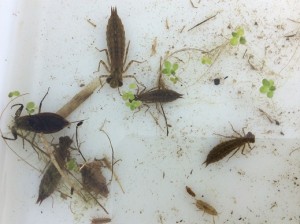
Pond dipping is a fantastic activity but often concerns about safety and a lack of knowledge about pond life identification skills deter people from giving it a go. However by following a few simple tips and guidelines you can safely run an exciting session and enjoy watching children discover the natural wonders of this watery world.
Children are drawn to, and have what seems an innate fascination of, water habitats. They all enjoy rooting around to see what they can find. What creatures live there, how and why? Community and school ponds should be treasured and looked after as both a valuable learning resource and as an important freshwater habitat for wildlife.
Here are my top tips for exploring this secret world:
Safety with water
Working alongside water can be hazardous and it’s important to visit the pond site to carry out a risk assessment. Every pond is different – size, depth, edge gradients and access – however with a sensible approach it is a low risk activity with high benefits. Check out www.rospa.com/leisure-safety/water/advice/pond-dipping/ for advice.
As a group decide on a suitable water safety code. Divide into groups of 2-3 and identify the safe pond dipping access points. Not everyone can pond dip together so have the group help sort through findings in a shared ‘community tray’ whilst waiting for their turn.
Be aware of bacterial infections – cover cuts and scratches on hands with a waterproof plaster.
Study code
Do not take too many creatures from the pond. For many investigations it’s the number of different species found not how many. Be gentle – don’t hold any creature with your fingers. Use plastic spoons to help sort the creatures in the trays. Make sure you always keep them in water and in the shade. Try to keep carnivores away from other creatures, otherwise you’ll see food chains in action! Once recorded carefully return to the pond as quickly as possible.
How to pond dip
Introduce the pond habitat and spend time collecting and observing species from the different zones of the pond: the surface, along the bottom, in the water and round the edge. Approach the pond quietly and record animals seen on the surface and edge such as pond skaters and amphibians that you’ll be unable to catch.
Put some pond water in a white collection tray and demonstrate how to sweep the net in a figure of 8 motion. Use a firm motion to help dislodge creatures from submerged plants into the net. Turn the net inside out into the tray and swish gently in the water to dislodge from the net.
Sort findings into smaller collection pots using plastic spoons or add to a community tray.
Pond dipping calendar
Be aware of seasonal changes, life cycles and weather conditions. Damselflies and dragonflies have emerged and are abundant in June. They are less active on sunny mornings after a cold night and easier to study. Look for their discarded nymphal casts (exoskeletons) on tall plant stems and reeds.
After dipping
Always remember to wash hands after pond dipping. Pond equipment hygiene is really important to stop the transfer of a deadly fungal disease to amphibians. Ideally, have your own designated equipment for the pond. If borrowing equipment, ensure the equipment is disinfected before using at other ponds. For further info go to www.froglife.org/what-we-do/disease-chytrid/
Ideas for activities
- Identification skills: How many different types of pond invertebrates did you find? Children love sorting finds into groups with similarities. Have trays labelled – 8 legs, 6 legs, many legs, no legs to help with classification. Then sort findings into detritivores (eats dead materials), herbivores and carnivores to start discussions about pond life food chains.
- Adaptations relay game: A fun activity to review how species eat, move and breathe in water. Divide the group into pairs, each with a picture of a pond invertebrate. Place on the ground, approx. 5m away, cards with a sentence describing an adaptation feature. For example, I can skate on the water surface, I breathe through my skin etc.. The children then have to run up individually in their teams to collect a card that matches their creature. First team to sit down wins. Then review to check they’ve collected the right adaptations!
- Pond health checks: How good is your pond habitat? Pond invertebrates are excellent bio-indicators and the quality of the water can be measured by recording their presence or absence. Use a biotic index to give each species a score to work out your water quality score.
